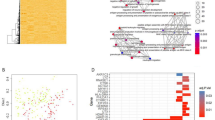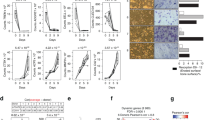Abstract
Introduction
The molecular and cellular interactions between the immune system and bone tissue have been established. Sex hormone deficiency after menopause has multifunctional role by influencing growth, differentiation, and metabolism of the skeletal and the immune system.
Discussion
We have used nonparametric and multidimensional expression pattern analyses to determine significantly changed mRNA profile of immune system-associated genes in postmenopausal (POST) and premenopausal (PRE) nonosteoporotic bone. Ten bone tissue samples from POST patients and six bone tissue samples from PRE women were examined in our study. The transcription differences of the selected 50 genes were analyzed in TaqMan probe-based quantitative real-time reverse transcriptase polymerase chain reaction system. Mann–Whitney test indicated significantly downregulated transcription activity of three genes (CD14, HLA-A/MHCI, ITGAM/CD11b) and upregulated expression of six genes (C3, CD86/B7-2, IL-10, IL-6, TGFB3, TNFSF11/RANKL) in postmenopausal bone. According to the canonical variate analysis results, the groups of POST and PRE women are separable by genes coding for cytokines, costimulator molecules, and cell surface receptors involved in antigen presentation and T cell stimulation processes which have high discriminatory power. Based on a complex gene expression pattern analysis of human bone tissue, we could distinguish POST and PRE states from an immunological aspect. Our data might provide further insight into the changes of the intersystem crosstalk between immune and skeletal homeostasis, as well as local immune response in the altered microenvironment of postmenopausal bone.

Similar content being viewed by others
References
Lorenzo J, Horowitz M, Choi Y. Osteoimmunology: interactions of the bone and immune system. Endocr Rev. 2008;29:403–40.
Walsh MC, Kim N, Kadono Y, et al. Osteoimmunology: interplay between the immune system and bone metabolism. Ann Rev Immunol. 2006;24:33–63.
Zallone A. Direct and indirect estrogen actions on osteoblasts and osteoclasts. Ann N Y Acad Sci. 2006;1068:173–9.
Bouman A, Heineman MJ, Faas MM. Sex hormones and the immune response in humans. Hum Reprod Updat. 2005;11:411–23.
Weitzmann MN, Pacifici R. Estrogen regulation of immune cell bone interactions. Ann N Y Acad Sci. 2006;1068:256–74.
Carlsten H. Immune responses and bone loss: the estrogen connection. Immunol Rev. 2005;208:194–206.
Clowes JA, Riggs BL, Khosla S. The role of the immune system in the pathophysiology of osteoporosis. Immunol Rev. 2005;208:207–27.
Safadi FF, Dissanayake IR, Goodman GG, et al. Influence of estrogen deficiency and replacement on T-cell populations in rat lymphoid tissues and organs. Endocr. 2000;12:81–8.
Deguchi K, Kamada M, Irahara M, et al. Postmenopausal changes in production of type 1 and type 2 cytokines and the effects of hormone replacement therapy. Menopause. 2001;8:266–73.
Kamada M, Irahara M, Maegawa M, et al. Transient increase in the levels of T-helper 1 cytokines in postmenopausal women and the effects of hormone replacement therapy. Gynecol Obstet Invest. 2001;52:82–8.
Cenci S, Toraldo G, Weitzmann MN, et al. Estrogen deficiency induces bone loss by increasing T cell proliferation and lifespan through IFN-gamma-induced class II transactivator. Proc Natl Acad Sci. 2003;100:10405–10.
Pacifici R. Estrogen deficiency, T cells and bone loss. Cell Immunol. 2008;252:68–80.
Kellgren JH, Lawrence JS. Radiological assessment of osteo-arthrosis. Ann Rheum Dis. 1957;16:494–502.
Balla B, Kosa JP, Kiss J, et al. Different gene expression patterns in the bone tissue of aging postmenopausal osteoporotic and non-osteoporotic women. Calcif Tissue Int. 2008;82:12–26.
Benayahu D. Estrogen effects on protein expressed by marrow stromal osteoblasts. Biochem Biophys Res Commun. 1997;233:30–5.
Podani J. Introduction to the exploration of multivariate biological data. Leiden: Backhuys; 2000.
Podani J. SYN-TAX 2000. User’s manual. Budapest: Scientia; 2001.
Romagnani S. Regulation of the T cell response. Clin Exp Allergy. 2006;36:1357–66.
Corthay A. A three-cell model for activation of naive T helper cells. Scand J Immunol. 2006;64:93–6.
Schuurhuis DH, Fu N, Ossendorp F, et al. Ins and outs of dendritic cells. Int Arch Allergy Immunol. 2006;140:53–72.
Steinman RM, Hemmi H. Dendritic cells: translating innate to adaptive immunity. Curr Top Microbiol Immunol. 2006;311:17–58.
Hornef MW, Wick MJ, Rhen M, et al. Bacterial strategies for overcoming host innate and adaptive immune responses. Nat Immunol. 2002;3:1033–40.
Moser M, Murphy KM. Dendritic cell regulation of TH1–TH2 development. Nat Immunol. 2000;1:199–205.
de Jong EC, Smits HH, Kapsenberg ML. Dendritic cell-mediated T cell polarization. Springer Semin Immunopathol. 2005;26:289–307.
Stopinska-Gluszak U, Waligora J, Grzela T, et al. Effect of estrogen/progesterone hormone replacement therapy on natural killer cell cytotoxicity and immunoregulatory cytokine release by peripheral blood mononuclear cells of postmenopausal women. J Reprod Immunol. 2006;69:65–75.
Carroll MC. The role of complement and complement receptors in induction and regulation of immunity. Annu Rev Immunol. 1998;16:545–68.
van Lookeren Campagne M, Wiesmann C, Brown EJ. Macrophage complement receptors and pathogen clearance. Cell Microbiol. 2007;9:2095–102.
Villiers MB, Perrin-Cocon L, Marche PN, et al. Complement receptors and B lymphocytes. Crit Rev Immunol. 2004;24:465–78.
Fan JD, Wagner BL, McDonnell DP. Identification of the sequences within the human complement 3 promoter required for estrogen responsiveness provides insight into the mechanism of tamoxifen mixed agonist activity. Mol Endocrinol. 1996;10:1605–16.
Wiethe C, Dittmar K, Doan T, et al. Enhanced effector and memory CTL responses generated by incorporation of receptor activator of NF-kappa B (RANK)/RANK ligand costimulatory molecules into dendritic cell immunogens expressing a human tumor-specific antigen. J Immunol. 2003;171:4121–30.
Salek-Ardakani S, Arens R, Flynn R, et al. Preferential use of B7.2 and not B7.1 in priming of vaccinia virus-specific CD8 T cells. J Immunol. 2009;182:2909–18.
Stanley KT, VanDort C, Motyl C, et al. Immunocompetent properties of human osteoblasts: interactions with T lymphocytes. J Bone Miner Res. 2006;21:29–36.
Gallo D, Battaglia A, Mantuano E, et al. 17beta-Estradiol and soy phytochemicals selectively induce a type 2 polarization in mesenteric lymph nodes of ovariectomized rats. Menopause. 2008;15:718–25.
Acknowledgments
This work was supported by grants NKFP-1A/007/2004 and NKFP-1A/002/2004 from the National Research and Technological Office (NKTH) of Hungary, as well as by research grant ETT 022/2006 from the Ministry of Health, Hungary. J. Podani was supported by a Hungarian Scientific Research Fund (OTKA) grant no. NI 68218. J. Kiss was supported by OTKA grant no. T-037436.
Conflict of interest
All the authors hereby state that they do not possess financial interests and they have no conflicts of interest.
Author information
Authors and Affiliations
Corresponding author
Additional information
J. P. Kósa and B. Balla equally contributed to this work.
Rights and permissions
About this article
Cite this article
Kósa, J.P., Balla, B., Kiss, J. et al. Postmenopausal Expression Changes of Immune System-Related Genes in Human Bone Tissue. J Clin Immunol 29, 761–768 (2009). https://doi.org/10.1007/s10875-009-9321-9
Received:
Accepted:
Published:
Issue Date:
DOI: https://doi.org/10.1007/s10875-009-9321-9




